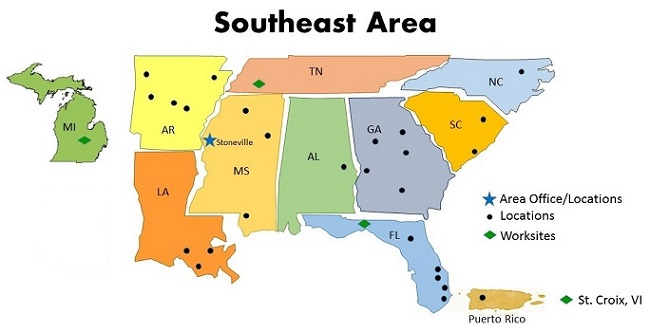Working for the USDA
Published:
In October 2021 I started a new job as an applied statistician for the Agricultural Research Service, a branch of the U.S. Department of Agriculture. As promised here are a few musings on my 6-month anniversary of becoming an employee of the federal government.
First of all, what exactly am I doing? My official job title is “Southeast Area Statistician.” That means I am responsible for the Southeast area, which includes North Carolina, Tennessee, South Carolina, Georgia, Florida, Alabama, Mississippi, Louisiana, Arkansas, and Puerto Rico. I have counterparts in the Northeast, Pacific West, Midwest, and Great Plains. There are four or five hundred scientists working for ARS in the Southeast area that I’m responsible for. Actually, that number just includes the P.I.s that lead labs. There are also a bunch of postdocs, techs, and students that work with them. Any of those people could contact me and ask me to help them with stats and data. That help could range from a 20-minute conversation to a collaboration lasting months.

Over the past six months, I have been working on all kinds of different projects. Just a few: testing different essential oil extracts to trap crop-damaging flies, using topography to predict soil moisture in pecan groves, using genomic data to predict which sugarcane varieties have the best traits and should be used in breeding programs, studying the effects of cover crops and rotations on crop output and disease resistance, developing a system to rate sweet potatoes for insect damage, and crossing soybean crops with their wild relatives to improve their traits. And those are just a few of the dozens of projects I’m contributing to.
I have two main long-term goals with USDA. The first, and most important, is to help improve the sustainability and climate resilience of agriculture in the United States, and by extension, of the global food system. The second is to reshape the way science, in particular how we analyze and interpret data, is done at USDA. In this post, I’m going to talk about the first one, and in a later post I will talk about the second one.
So let’s talk a little about the sustainability and resilience of agriculture in the United States. It’s clear that we could be doing a better job of balancing feeding the world in the short term and protecting the natural environment that sustains us and all other living things in the long term. That job is only going to get harder as the climate becomes less benign and more extreme, making it harder to reliably produce food. We have lots of technology and infrastructure to produce abundant food, but it comes at a high environmental cost and we do a poor job of getting that food to the people who need it.
I have been inspired so far by the research being done at USDA to make agriculture more sustainable, with a lower environmental impact, as well as to develop crops and techniques that will be resilient to negative human-caused changes in the climate. I think it’s important to support that research in any way possible. That’s because reducing agriculture’s land and resource footprint, and making sure that we can continue to feed everyone even as climate change makes it harder to support agriculture, are both really time-sensitive. We have to fix those problems now.

While the scientists and other folks that work at ARS are contributing to fixing these huge problems, it’s far from perfect: the USDA also has a mandate to promote the profitability of U.S. agriculture. I’m a strong advocate for plant-based diets, as you may have noticed from previous posts on this blog, but USDA is heavily involved in animal agriculture. ARS is no exception. So that’s definitely a complex issue. In addition, a good amount of the research at ARS is focused on increasing yield, or the efficiency of how much food is produced per unit land area. This often comes at the cost of requiring a lot bigger input of chemicals and fossil fuels to wring higher yield out of that piece of land. I think that it’s critical to try to achieve those yield improvements, to benefit both agricultural productivity itself and conservation goals: if we can increase yields on the land we have already converted to agriculture, we can continue to set aside land where ecosystems and communities of organisms can persist and provide beneficial sevices. But I think we also need to consider whether those yield improvements are worth whatever additional inputs are needed to maintain that increased yield. Agricultural research, and the policy it helps drive, has to face those kind of difficult trade-offs.
I am still considering it deeply, but I do believe that the global agricultural-industrial complex, with all its benefits and flaws, is not going to disappear overnight. We desperately need to make change from within, and I think the research at ARS is a critical part of that. It sounds trite but I think that working at ARS is an important way for me to serve my country and effect positive global change.

Leave a Comment